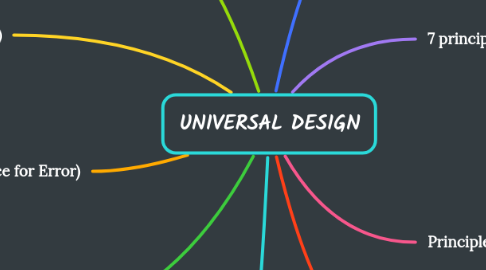
1. Definition
1.1. Process of designing products so that they can be used by as many people as possible in as many situations as possible
2. 7 principles of Universal Design
2.1. Equitable use
2.2. Flexibility in use
2.3. Simple and intuitive to use
2.4. Perceptible information
2.5. Tolerance for error
2.6. Low physical effort
2.7. Size and space for approach and use
3. Principle 1 (Equitable Use)
3.1. The design is useful and marketable to people with diverse abilities
3.1.1. Provide the same means of use for all users: - identical whenever possible and equivalent when not.
3.1.2. Avoid segregating or stigmatizing any users. Provisions for privacy, security, and safety should be equally available to all users.
4. Principle 2 (Flexibility in Use)
4.1. The design accommodates a wide range of individual preferences and abilities
4.1.1. Provide choice in methods of use. Accommodate right- or left handed access and use.
4.1.2. Provide adaptability to the user's pace.
5. Principle 7 (Size and Space for Approach and Use)
5.1. Appropriate size and space is provided for approach,reach, manipulation, and use regardless of user's body size, posture, or mobility
5.1.1. Provide a clear line of sight to important elements for any seated or standing user.
5.1.2. Make reach to all components comfortable for any seated or standing user.
5.1.3. Provide adequate space for the use of assistive devices or personal assistance.
6. Principle 6 (Low Physical Effort)
6.1. The design can be used efficiently and comfortably and with a minimum of fatigue
6.1.1. Allow user to maintain a neutral body position.
6.1.2. Minimize sustained physical effort.
6.1.3. Minimize repetitive actions.
7. Principle 3 (Simple and Intuitive Use)
7.1. Use of the design is easy to understand, regardless of the user's experience, knowledge, language skills, or current concentration level
7.1.1. Eliminate unnecessary complexity. Be consistent with user expectations and intuition.
7.1.2. Accommodate a wide range of literacy and language skills.
7.1.3. Provide effective prompting and feedback during and after task completion.
8. Principle 4 (Perceptible Information)
8.1. The design communicates necessary information effectively to the user, regardless of ambient conditions or the user's sensory abilities
8.1.1. Provide adequate contrast between essential information and its surroundings.
8.1.2. Use different modes (pictorial, verbal, tactile) for redundant presentation of essential information.
8.1.3. Provide compatibility with a variety of techniques or devices used by people with sensory limitations.
9. Principle 5 (Tolerance for Error)
9.1. The design minimizes hazards and the adverse consequences of accidental or unintended actions
9.1.1. Arrange elements to minimize hazards and errors: most used elements, most accessible; hazardous elements eliminated, isolated, or shielded.
9.1.2. Discourage unconscious action in tasks that require vigilance.
